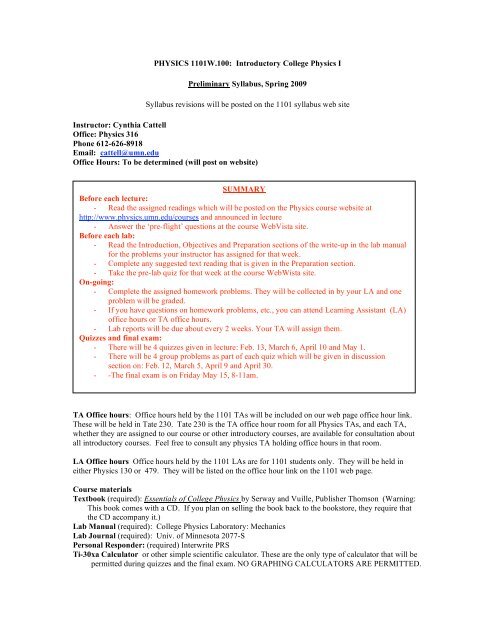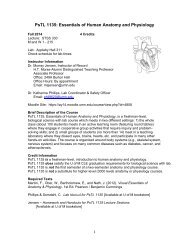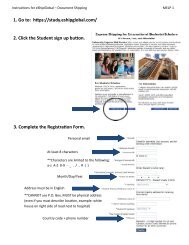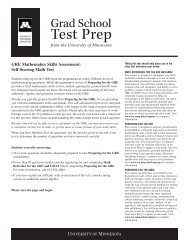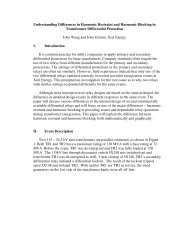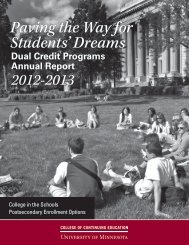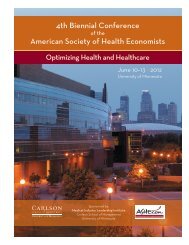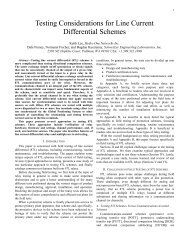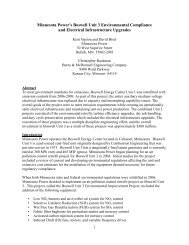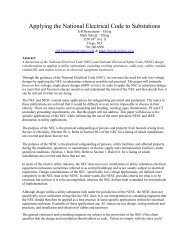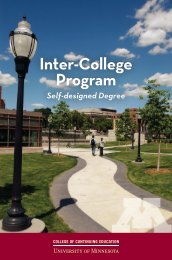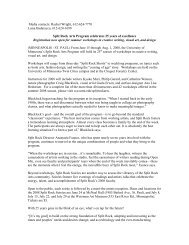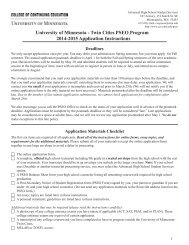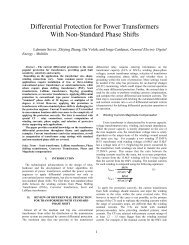Sample syllabus - College of Continuing Education - University of ...
Sample syllabus - College of Continuing Education - University of ...
Sample syllabus - College of Continuing Education - University of ...
You also want an ePaper? Increase the reach of your titles
YUMPU automatically turns print PDFs into web optimized ePapers that Google loves.
PHYSICS 1101W.100: Introductory <strong>College</strong> Physics I<br />
Preliminary Syllabus, Spring 2009<br />
Syllabus revisions will be posted on the 1101 <strong>syllabus</strong> web site<br />
Instructor: Cynthia Cattell<br />
Office: Physics 316<br />
Phone 612-626-8918<br />
Email: cattell@umn.edu<br />
Office Hours: To be determined (will post on website)<br />
SUMMARY<br />
Before each lecture:<br />
- Read the assigned readings which will be posted on the Physics course website at<br />
http://www.physics.umn.edu/courses and announced in lecture<br />
- Answer the ‘pre-flight’ questions at the course WebVista site.<br />
Before each lab:<br />
- Read the Introduction, Objectives and Preparation sections <strong>of</strong> the write-up in the lab manual<br />
for the problems your instructor has assigned for that week.<br />
- Complete any suggested text reading that is given in the Preparation section.<br />
- Take the pre-lab quiz for that week at the course WebWista site.<br />
On-going:<br />
- Complete the assigned homework problems. They will be collected in by your LA and one<br />
problem will be graded.<br />
- If you have questions on homework problems, etc., you can attend Learning Assistant (LA)<br />
<strong>of</strong>fice hours or TA <strong>of</strong>fice hours.<br />
- Lab reports will be due about every 2 weeks. Your TA will assign them.<br />
Quizzes and final exam:<br />
- There will be 4 quizzes given in lecture: Feb. 13, March 6, April 10 and May 1.<br />
- There will be 4 group problems as part <strong>of</strong> each quiz which will be given in discussion<br />
section on: Feb. 12, March 5, April 9 and April 30.<br />
- -The final exam is on Friday May 15, 8-11am.<br />
TA Office hours: Office hours held by the 1101 TAs will be included on our web page <strong>of</strong>fice hour link.<br />
These will be held in Tate 230. Tate 230 is the TA <strong>of</strong>fice hour room for all Physics TAs, and each TA,<br />
whether they are assigned to our course or other introductory courses, are available for consultation about<br />
all introductory courses. Feel free to consult any physics TA holding <strong>of</strong>fice hours in that room.<br />
LA Office hours Office hours held by the 1101 LAs are for 1101 students only. They will be held in<br />
either Physics 130 or 479. They will be listed on the <strong>of</strong>fice hour link on the 1101 web page.<br />
Course materials<br />
Textbook (required): Essentials <strong>of</strong> <strong>College</strong> Physics by Serway and Vuille, Publisher Thomson (Warning:<br />
This book comes with a CD. If you plan on selling the book back to the bookstore, they require that<br />
the CD accompany it.)<br />
Lab Manual (required): <strong>College</strong> Physics Laboratory: Mechanics<br />
Lab Journal (required): Univ. <strong>of</strong> Minnesota 2077-S<br />
Personal Responder: (required) Interwrite PRS<br />
Ti-30xa Calculator or other simple scientific calculator. These are the only type <strong>of</strong> calculator that will be<br />
permitted during quizzes and the final exam. NO GRAPHING CALCULATORS ARE PERMITTED.
Supplementary (optional) course materials: The Competent Problem Solver for Introductory Physics, by<br />
Heller and Heller.<br />
Course Overview:<br />
Physics 1101 is the first semester <strong>of</strong> a two semester introduction to physics. The main emphasis will<br />
be on the branch <strong>of</strong> physics known as mechanics. This is the study <strong>of</strong> motion and the causes <strong>of</strong><br />
motion through the applications <strong>of</strong> fundamental principles <strong>of</strong> physics. We begin with kinematics, the<br />
quantitative description <strong>of</strong> the motion <strong>of</strong> particles. We then build on kinematics to learn how and why<br />
motion occurs, through the application <strong>of</strong> Newton's laws <strong>of</strong> dynamics. Many examples will be<br />
considered as we explore the properties <strong>of</strong> specific forces and the details <strong>of</strong> the motion they bring<br />
about. The next step will be to describe physical processes in terms <strong>of</strong> energy and momentum,<br />
quantities that are always "conserved." Conservation laws allow us to solve problems in mechanics<br />
that would be very difficult by other techniques and provide a powerful approach to the analysis <strong>of</strong><br />
physical systems in general. We then will extend our understanding <strong>of</strong> motion to the kinematics and<br />
dynamics <strong>of</strong> rotation. Finally, we will briefly study some <strong>of</strong> the physical properties <strong>of</strong> solids and<br />
fluids. By the end <strong>of</strong> this semester, you should have a deeper understanding <strong>of</strong> the phenomena<br />
occurring in your surrounding physical world. You should have a clearer picture <strong>of</strong> the behavior <strong>of</strong><br />
the universe on the largest (cosmic) scale, and on the smallest (subnuclear) scale. You should also<br />
understand a bit more about the physics <strong>of</strong> biological systems, including your own body. In addition,<br />
you should be more competent at measurement and quantitative reasoning concerning physical<br />
processes.<br />
Prerequisites<br />
No prior physics course is assumed, but facility in algebra and basic trigonometry is essential. If you<br />
feel rusty you should review and practice. Chapter 1 and Appendices A through D in your text<br />
provide an overview <strong>of</strong> the tools you will need.<br />
Work Load<br />
This is a demanding course. There is a lot to learn. The course moves at a fast pace. Since each new<br />
topic builds on previous work, it is <strong>of</strong> great importance that you do not fall behind. You should<br />
expect and plan for a workload consistent with <strong>University</strong> policy (three hours per week per credit for<br />
a total <strong>of</strong> twelve hours per week for an average student to receive an average grade). This amounts to<br />
at least six hours per week outside <strong>of</strong> scheduled class meetings.<br />
Lectures - M W F (1:25-2:15) in Physics 150.<br />
In lecture we will motivate and introduce new material, analyze example problems, and generally<br />
work to organize and interpret the knowledge accumulated in your reading, in lab, and in other course<br />
activities. Our task will be to elaborate on important and difficult ideas, and to clarify points that may<br />
be confusing. We will utilize a variety <strong>of</strong> tools and devices to assist in clarifying concepts and<br />
methods. Lecture demonstrations will be used to illustrate new concepts, and we will attempt to<br />
recognize and address misconceptions that arise. In-class clicker questions will be posed for class<br />
response using the personal responder. We will develop strategies for solving problems that will be<br />
applied and reinforced in discussion sessions and labs. Clicker questions and other problem solving<br />
will be <strong>of</strong>ten been done in groups, facilitated by the Learning Assistants. It is impossible to cover all<br />
<strong>of</strong> the details in lecture, and it is not our intention to duplicate the text. You should complete assigned<br />
reading (see below) and associated pre-flight questions before attending class. By preparing in<br />
advance and asking informed questions you can help ensure that class time is used to maximum<br />
advantage. Early in the semester we will introduce a semi-formal strategy for solving physics<br />
problems. We will do examples using this procedure, and you will be required to apply it explicitly in<br />
solving homework, discussion session and test problems.<br />
Reading and Problem Assignments
Your primary learning tools in this course is the working <strong>of</strong> physics problems from your text<br />
and provided by us. This includes homework problems and in-class problems. Any <strong>of</strong> these problems<br />
can appear in the class quizzes. One homework problem in each assignment will be graded. There<br />
will also be a grade associated with pre-flight and clicker questions (see below).<br />
It is important to solve physics problems, whether they are simple exercises or context rich<br />
problems, as best as you can before examining the solution provided by an “expert.” As the first step<br />
in this, it may be most beneficial to your reading if you treat the examples given in the text as<br />
problems, solving them yourself before you read the authors’ solutions. You do not understand how<br />
to solve a problem, and the underlying physical principles or their application to the problem, until<br />
you can find the solution without looking at someone else’s solution. Working problems is the only<br />
reliable way to test your understanding <strong>of</strong> a topic. Try as many <strong>of</strong> problems as you have time for,<br />
emphasizing first the problems that you have or will have solutions to compare your work to. If your<br />
answer agrees with the one given in some form, fine. If not, or if you can’t come up with any answer,<br />
seek help from the 1101 instructional team, including the TAs in the Physics Tutoring Room (Room<br />
230), or your LA. Some <strong>of</strong> your fellow students are also potentially good resources. Doing physics<br />
problems is hard work, but you will be rewarded by a deeper understanding and sense <strong>of</strong><br />
accomplishment. The test problems will be <strong>of</strong> the same type and general level <strong>of</strong> difficulty as the<br />
problems that you will be assigned, or presented in lecture, or worked on by your group in your<br />
discussion section.<br />
As mentioned above, we will develop strategies for solving problems. The <strong>University</strong> <strong>of</strong> Minnesota<br />
Physics <strong>Education</strong> Research Group has long been at the forefront <strong>of</strong> the study <strong>of</strong> how skilled problem<br />
solvers actually solve problems, particularly those that are more complex than the simpler exercises<br />
and examples, and more like real world situations. Much <strong>of</strong> this is detailed in “The Competent<br />
Problem Solver” which is optional for this course. In order to illustrate a common strategy <strong>of</strong> expert<br />
problem solvers, we will first apply it to simple problems, so simple that most <strong>of</strong> you could solve<br />
them much faster than an application <strong>of</strong> this method. While the discipline <strong>of</strong> using this method on<br />
simple problems may at first seem frustrating, it generally pays <strong>of</strong>f when the problems become more<br />
difficult. (This can also serve as a paradigm for solving non-physics “problems” in other contexts<br />
that you might deal with.)<br />
Responder and Pre-flight Questions<br />
Several “pre-flight” questions based on the assigned reading will be posted on the course WebVista<br />
site to help you and us gauge and pace your reading. These must be answered on the web before<br />
class by 9 am the day <strong>of</strong> class and will be graded in part according to participation and in part<br />
according to correctness. Ordinarily during class there will be several “clicker” (responder)<br />
questions, which are also graded. “Clicker” questions are graded only on the basis <strong>of</strong><br />
correctness. These will relate to the concepts that are introduced in your reading and during the<br />
lecture, and demonstrations that are given in lecture. The points for these clicker and pre-flight<br />
questions will be included in your final grade.<br />
Discussion Sessions: Thursdays at 1:25 or 2:30 pm<br />
In discussion sessions you work with classmates, your LA and TA to solve a challenging problem in<br />
small groups. Some analysis <strong>of</strong> the solution will be presented at the end <strong>of</strong> the session. On quiz<br />
week, there will be a group problem in the discussion section, which will count for 25% <strong>of</strong> the total<br />
quiz grade. Your group will solve that problem collaboratively with all group members receiving the<br />
same score for that problem. Only those participating in all discussion sessions during the<br />
preceding weeks will be allowed to take the group part <strong>of</strong> the quiz. The TA will assign the groups<br />
and new groups will be assigned after each quiz.<br />
Laboratories:<br />
You have the same TA and work in the same group as in your discussion session. Labs are roughly<br />
coordinated with lectures, and are designed to give you an opportunity to test, expand and refine your<br />
understanding <strong>of</strong> basic physics concepts . Careful recording <strong>of</strong> observations in your lab journal and<br />
preparation <strong>of</strong> formal lab reports are important parts <strong>of</strong> this experience. Since you carry out the lab<br />
exercises in a group and the equipment for each lab is available for only a limited time, make-ups are
not possible. You will need to consult as soon as possible with your lab instructor (TA) if an<br />
<strong>of</strong>ficially excused absence from lab proves unavoidable.<br />
Because this course satisfies <strong>University</strong> requirements as a laboratory science class and as a writing<br />
intensive course, you must receive a minimum laboratory grade <strong>of</strong> 60% to receive a passing grade<br />
in the course. The laboratory grade will be based on the demonstration <strong>of</strong> a well organized and correct<br />
written technical communication <strong>of</strong> the physics concepts <strong>of</strong> this course in your laboratory journal and<br />
laboratory reports, well thought out predictions and answers to the questions in the laboratory manual<br />
brought to class, and collaborative skills as evidenced by effective group work. To ensure that you have<br />
a conceptual introduction to the physics and mathematical concepts needed for beginning the lab, you<br />
will take a computerized quiz on the textbook reading that is preparation for each lab. No one will be<br />
allowed to participate in the laboratory unless they have passed the computerized preparation<br />
quiz for that topic. Failure to participate in the laboratory will result in a laboratory grade <strong>of</strong> 0 for that<br />
topic. There are no make-up laboratories. The laboratory preparation quiz is available on the web.<br />
It is an open book, open notes quiz. The quiz may be taken as <strong>of</strong>ten as necessary but must be passed<br />
by 5 PM the evening before your scheduled laboratory session. A passing grade is approximately<br />
75%. If you fail to pass the quiz after two attempts, get help from your instructors or fellow students.<br />
Leave time to get help so don’t wait to take the quiz at the last minute. No laboratory makeup will be<br />
allowed except in situations <strong>of</strong>ficially recognized by the <strong>University</strong>. In that case, the laboratory work<br />
must be made up by arrangement with your instructor before your next scheduled laboratory period.<br />
Grades for the laboratory work will be determined in part by laboratory reports (one for each<br />
laboratory topic), in part by your work in the laboratory, in part by a final laboratory exam, and<br />
in part by your work in answering the prediction and other questions turned in before lab. The<br />
predictions and questions assigned by your TA must be turned in no later than 5pm, 2 days before the<br />
laboratory each week. The specific part <strong>of</strong> the laboratory for which you will write a report will be<br />
assigned to you by your instructor at the end <strong>of</strong> each laboratory topic (about every two weeks). Reports<br />
should be no longer than 5 nor shorter than 3 typed pages (using a word processor is required and such<br />
facilities are supplied by the <strong>University</strong>) including all necessary predictions, graphs, data tables, and<br />
calculations. Reports must be delivered to your laboratory instructor for grading no more than 2 days<br />
after they are assigned. Late reports will not be accepted. Graded reports will be returned to you not<br />
later than your next laboratory meeting and, with instructor permission, may be revised based on<br />
instructor comments to achieve a higher grade. If a revised report is allowed, it must be given to your<br />
laboratory instructor within 2 days. Details <strong>of</strong> the laboratory grading are in your laboratory manual.<br />
Remember this is a writing intensive course so your grade will depend on your communication skills.<br />
Quizzes and Final Exam<br />
There will be four quizzes, each in two parts. The second part will be a lecture hour quiz and will<br />
occur on the following Fridays during lecture time: Feb. 13, March 6, April 10 and May 1. The first<br />
part <strong>of</strong> each quiz will be a group quiz during the discussion section on the Thursday preceding the<br />
Friday quizzes (i.e on Feb. 12, March 5, April 9 and April 30). The lecture hour part <strong>of</strong> the quiz is<br />
75% <strong>of</strong> the quiz grade, while the discussion section part <strong>of</strong> the quiz is the remaining 25%.<br />
The three-hour final exam is on Friday May 15, 8:00-11:00. The location will be announced closer<br />
to that date.<br />
o The quizzes and final exam will consist <strong>of</strong> a mixture <strong>of</strong> multiple choice questions and<br />
longer worked problems. A sheet <strong>of</strong> equations and other useful information will be<br />
provided. No books or notes will be allowed. Only a TI-30xa or equivalent simple<br />
scientific pre-approved calculator will be allowed. No graphing or programmable<br />
calculators will be permitted. The use <strong>of</strong> any communication devices (cell phones,<br />
messaging devices, etc.) during examinations is not allowed.<br />
o To be successful in problem solving you must get the physics right and communicate your<br />
understanding clearly and effectively. To receive full credit on any problem, your solution<br />
must be complete and understandable to the grader, with clear algebraic formulation <strong>of</strong> the<br />
physics, explicit definitions <strong>of</strong> all the symbols used, and proper handling <strong>of</strong> units and<br />
significant figures. In general, problems must be solved algebraically before numbers are<br />
substituted (one exception is that plugging in zero should be done when appropriate to<br />
simplify the algebra). We will go over problem solving procedure in class.
o<br />
A valid picture ID will be required on exam days. Examples <strong>of</strong> a valid ID are a <strong>University</strong><br />
ID or Driver’s License.<br />
No make-up quizzes are given. See make-up policy below.<br />
Tentative Plan:<br />
Week Topic Chapter(s)<br />
1 - 2 Introduction, kinematics in one dimension 1&2<br />
3 - 4 Complete kinematics: two-dimensional motion, including 3; 7.1-7.3<br />
circular motion<br />
5 – 6 Newton's laws <strong>of</strong> motion 4; 7.4-7.6<br />
7 - 8 Work and energy 5<br />
9-10 Momentum and collisions 6<br />
11 - 13 Rotational kinematics and Dynamics 8<br />
14 Solids and Fluids 9<br />
Grading:<br />
7% for responder and pre-flight questions (Scores for lowest 3 days for each will be dropped)<br />
8% for homework problems (Lowest homework score will be dropped)<br />
15% for the laboratory. Completion <strong>of</strong> all labs, and a lab grade <strong>of</strong> at least 60% will be required to pass<br />
the course.<br />
45% for best 3 out <strong>of</strong> 4 quizzes (15% per quiz, including both the lecture and discussion section parts<br />
<strong>of</strong> the quiz). The lowest quiz score is dropped.<br />
25% for three-hour final examination.<br />
[Note: If it will result in a higher grade, all 4 quizzes will be included and the final will only count<br />
20%. Your grade will be calculated both ways and the highest will be used.]<br />
Your course grade will be calculated on an absolute scale, as follows:<br />
A: 100 - 90%, A-: 90 - 85%, B+: 85 - 80%, B: 80 - 75%,<br />
B-: 75 - 70%, C+: 70 - 65%, C: 65 - 60%, C-: 60 - 55%,<br />
D+: 55 - 50%, D 50-40%, F:
completed.<br />
CHEATING: Don’t do it!<br />
All work that you turn in for a grade must be your own. The following behaviors are considered to be<br />
cheating.<br />
a. Using the responder <strong>of</strong> another student<br />
b. Copying all or part <strong>of</strong> a lab report, data table or fabrication <strong>of</strong> data (see Intro, pg. 3 <strong>of</strong> Lab<br />
Manual)<br />
c. Copying all or part <strong>of</strong> a homework assignment or exam<br />
d. Any other matter covered by the <strong>University</strong> statement below.<br />
Your TAs are observant. They notice duplication in lab reports.<br />
Mandatory Statement about academic integrity:<br />
The <strong>University</strong> expects the highest standards <strong>of</strong> honesty and integrity in the academic performance <strong>of</strong><br />
its students. Any act <strong>of</strong> scholastic dishonesty is regarded as a serious <strong>of</strong>fense, which may result in<br />
expulsion. Scholastic dishonesty is defined as submission <strong>of</strong> false records <strong>of</strong> academic achievement;<br />
cheating on assignments or examinations; plagiarizing, altering, forging, or misusing an academic<br />
record; taking, acquiring, or using test materials without faculty permission; acting alone or in<br />
cooperation with another to obtain dishonestly grades, honors, submission <strong>of</strong> false records <strong>of</strong> academic<br />
achievement; cheating on assignments or examinations; plagiarizing, altering, forging, or misusing an<br />
academic record; taking, acquiring, or using test materials without faculty permission; acting alone or<br />
in cooperation with another to obtain dishonestly grades, honors, awards, or pr<strong>of</strong>essional endorsement.<br />
Aiding and abetting an act <strong>of</strong> scholastic dishonesty is also considered a serious <strong>of</strong>fense with the same<br />
possible consequences. Students may not make commercial use <strong>of</strong> their notes <strong>of</strong> lectures or<br />
<strong>University</strong>-provided materials without the express written consent <strong>of</strong> the instructor. (See the Senate<br />
policy at http://www1.umn.edu/usenate/policies/classnotes.html.)<br />
Academic dishonesty in any portion <strong>of</strong> the academic work for a course shall be grounds for awarding a<br />
grade <strong>of</strong> F or N for the entire course.<br />
Classroom courtesy<br />
Lectures end when the idea or technique under discussion has been concluded and the lecturer<br />
has indicated that the students are free to leave. For this reason lectures are rarely expected to end<br />
exactly at the end <strong>of</strong> class time. Packing up books, putting on coats, or standing up while the lecture is<br />
in progress interferes with the learning <strong>of</strong> other students and shows disrespect for the educational<br />
process. Those who must leave early should sit near the end <strong>of</strong> a row to minimize the disturbance they<br />
will inflict on the other students, however consistent with a seating plan that will be introduced to<br />
optimize group activities. Cell phones, MP3 players and similar devices must not be used and must be<br />
turned <strong>of</strong>f during the lecture period. Computers may only be used for taking class notes, and<br />
keyboarding must not be a disturbance to other members <strong>of</strong> the class. Note that food and drinks are not<br />
allowed in Room 150.<br />
Physics 1101 is has an interactive lecture. If you choose not to participate, you will be excused from<br />
lecture.


